Last week, for me, was defined by two things.
First, I was sick as a dog and thus spent my two days off shuffling from my bed to the sofa and back again, playing a lot of Football Manager and feeling sorry for myself.
Second, I wrote a lot – a lot a lot – of squad previews for the upcoming Rugby League World Cup, which you might have noticed dropping across The Roar as we ramp up our coverage of the tournament.
You can add a third: I read this superb piece by John Muller in The Athletic (paywall) that made me think a lot about the first two things.
For those without an Athletic sub, Muller’s article tries to rethink soccer positions in a way that divorces them, a little bit at least, from on-field geography.
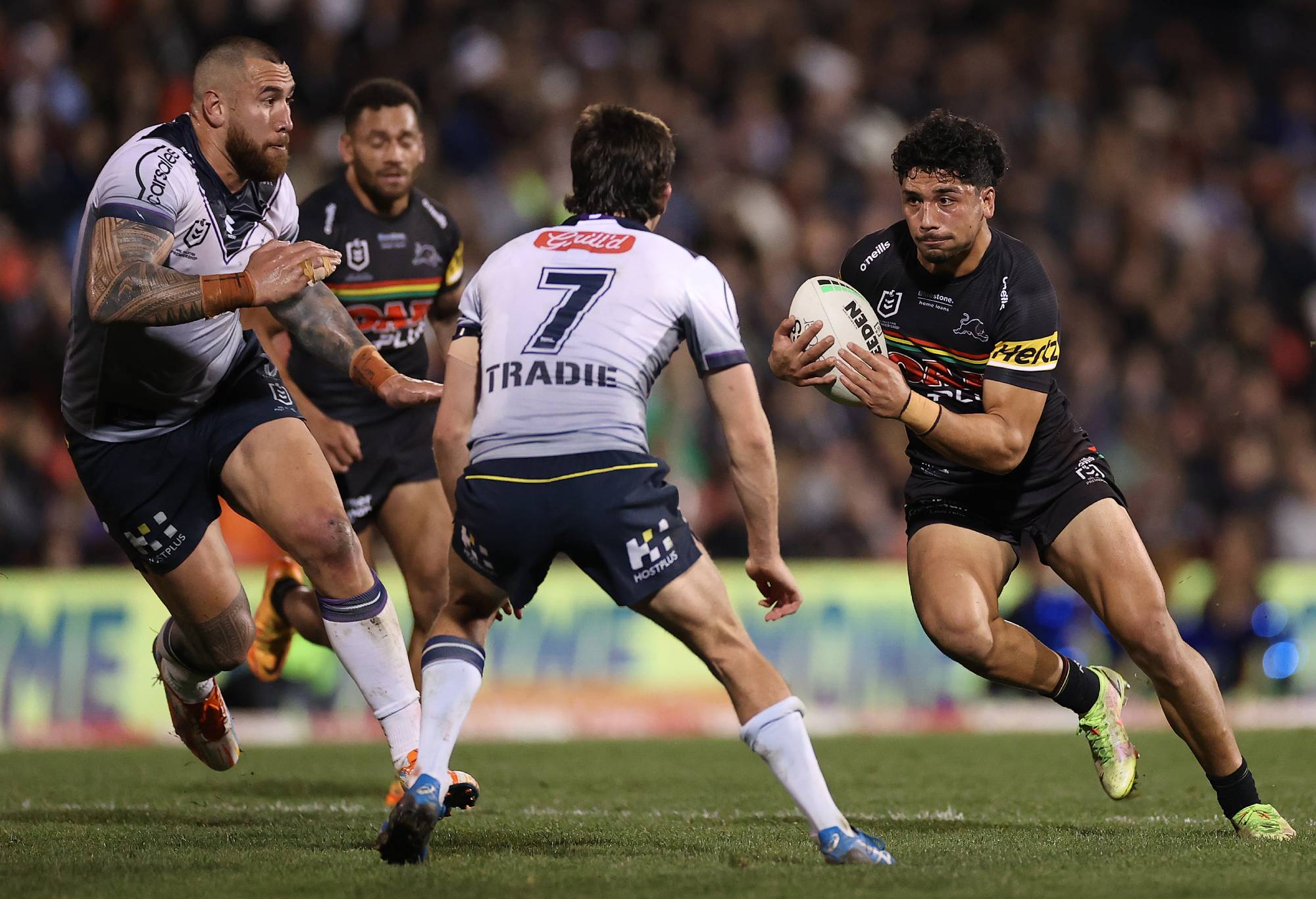
(Photo by Cameron Spencer/Getty Images)
It’s an interesting idea to convert into rugby league because our tactics are, perhaps even more than football, still defined by where a player stands on the field, but with little emphasis on what they do.
We essentially decided on what every player does based on where they stand about a century ago and haven’t changed a great deal since, despite almost all the rules changing immeasurably.
We have front and back-rowers, but anyone can and does stand wherever the want in scrums. We have wingers that take central hit-ups, fullbacks that play in the line and hookers that haven’t struck at the ball in their entire careers. It’s time for a rethink.
Football Manager made me think of this too. For those with social lives, Football Manager is a video game where you play as, surprise surprise, a football manager.
If you’re my partner, it’s a permanent confusion as to why I spend my life looking at spreadsheets and sending emails for work, and then decide to do the same thing but as an imaginary football coach in a suit.
In FM, you place players in positions, but also give them a role: your striker can be a poacher, a pressing forward, a target man, a false nine and that’s just some of them.
You don’t need to know what any of that means, by the way. The point is just because someone stands in one place on the field, they can be doing a lot of different things while they’re stood there.
In writing the RLWC previews, I noticed there were clusters of players per team that matched up, not just in terms of having lots of, say, locks, but also in having the same type of lock.
Ireland had lots of workmanlike, not huge but very tough forwards. Tonga have lots of tackle-breaking but error-prone back-rowers. Samoa have a glut of low-minute, high-intensity props.
You’ll remember this from Origin, too. NSW had five ball-playing locks, so many that one, Cameron Murray, ended up playing as an edge back-rower, another, Jake Trbojevic, ended up as a prop and a third, Victor Radley, is so far out of it he’s given up on Origin entirely to become English.
When you think of the distinction between a position and a role, it makes sense to think less about the location and more about the task.

Jake Trbojevic. (Photo by Paul Kane/Getty Images)
This is what Muller was on about in his article, and what inspired me to think about it in the context of rugby league – namely: if we were to redraw new positions based on activity over location, what would they be?
His methodology was to define certain roles, then mine the stats to find who best exemplified them. I’ve had a crack at the same job, although somewhat the other way around stats-wise: I’ve focssed on what metrics you might follow to judge a player in their role.
This is partly a reaction to one of my pet hates: using the wrong stat to judge what a player without context of whether that stat actually corresponds to what they were meant to be doing.
Knowing Dylan Edwards made 200 metres is vaguely useful, but totally useless for judging if, say, Reece Walsh was any good. It’s like getting Tevita Tatola’s kicking metres. I’m great fun at parties…
For our role analysis, we’ve split forwards, backs, spine and interchanges – yes, interchanges are a position – to give an overview of what different roles exist and how they are balanced across the field.
A minor caveat: obviously, the very best players will likely be more than one role, and just because I’ve named someone in one role, it doesn’t mean they can’t do others. It’s a guideline, and do let me know how wrong I am in the comments.
A second caveat: on speaking about his place, Muller said that the biggest point of argument was the names that he had picked. I don’t own the names, I just made them up for illustrative purposes. Again, suggest your own.

(Photo by Mark Kolbe/Getty Images)
Grunt
OK, so we start up front with the barry basics, nothing more nothing less – Grunt. Everyone needs one, probably two. We measure these guys really simply: hit-ups, metres, minutes.
We’re not expecting anything more: we don’t need offloads, we don’t need ball-playing and we don’t need impact. These guys absorb impact. 50-60 minutes per game, set and forget.
Christian Welch is their king, Luke Thompson is another and, just because they’re not always props, Tariq Sims also counts – nine passes in 17 games will do that. Head down, bum up.
There’s a subsection of these guys, which is the interchange grunt. They do the same thing, but for fewer minutes. Often it’s guys at either end of the age spectrum, who are either great for culture – Mark Nicholls, Aiden Tolman – or not to be trusted with big minutes yet – say, Fletcher Baker.
Ball-player
The ball-player might be the best example for understanding why different roles exist for the same position. Are Junior Paulo and Isaah Yeo the same position? Absolutely not. Do they perform the same role? Well…maybe yes.
The point of this person is to be the set of hands that gets the ball to the halves wider from the ruck, while also offering a legitimate run threat. Note: legitimate run threat. That’s what differentiates the true ball-player from a ball-mover, a Yeo or Paulo from a Jake Trbojevic or a Josh Jackson.
So we use General Play Passes (GPP) and Pass per Run ratio (PPR) to work out who is doing the passing, but also line engagements, LE, to work out whether they are actually interesting the line or not.

(Photo by Brett Hemmings/Getty Images)
Second phase specialist
Closely related to the ball-player is the Second Phase Specialist. These are the guys getting the arm free, with usually heavier upper bodies that are experts at getting the arm free.
Again, they have to be legitimate threats with their running, but look to initiate contact on their terms and allow that second phase to follow, so we rank them for metres, but heavily for offloads.
Tevita Pangai jnr is the currently NRL champ of this, Joe Tapine is also an expert. But it isn’t only middles: Shaun Lane also does a good trade in it because of his height, while Siliva Havili is quietly excellent at from the other end of the height scale, because of his low centre of gravity. He’s got the close to the most offloads per minute played in the NRL.
Striker
You want your forwards to lay a platform, sure, but also to make an impact. This is where the strike player comes in.
They can be found across the field, however: Jeremiah Nanai, Isaiah Papali’i and Haumole Olakau’atu would be the standout examples of the genre in the back row, but Tino Fa’asuamaleaui does it through the middle, topping the props for line breaks, and Jason Taumalolo isn’t too bad either.
Stats aside, we’re looking for bulk, but also footwork, tackle busts and offloads – not mention, on the flipside, a few missed tackles or two that come with the territory.
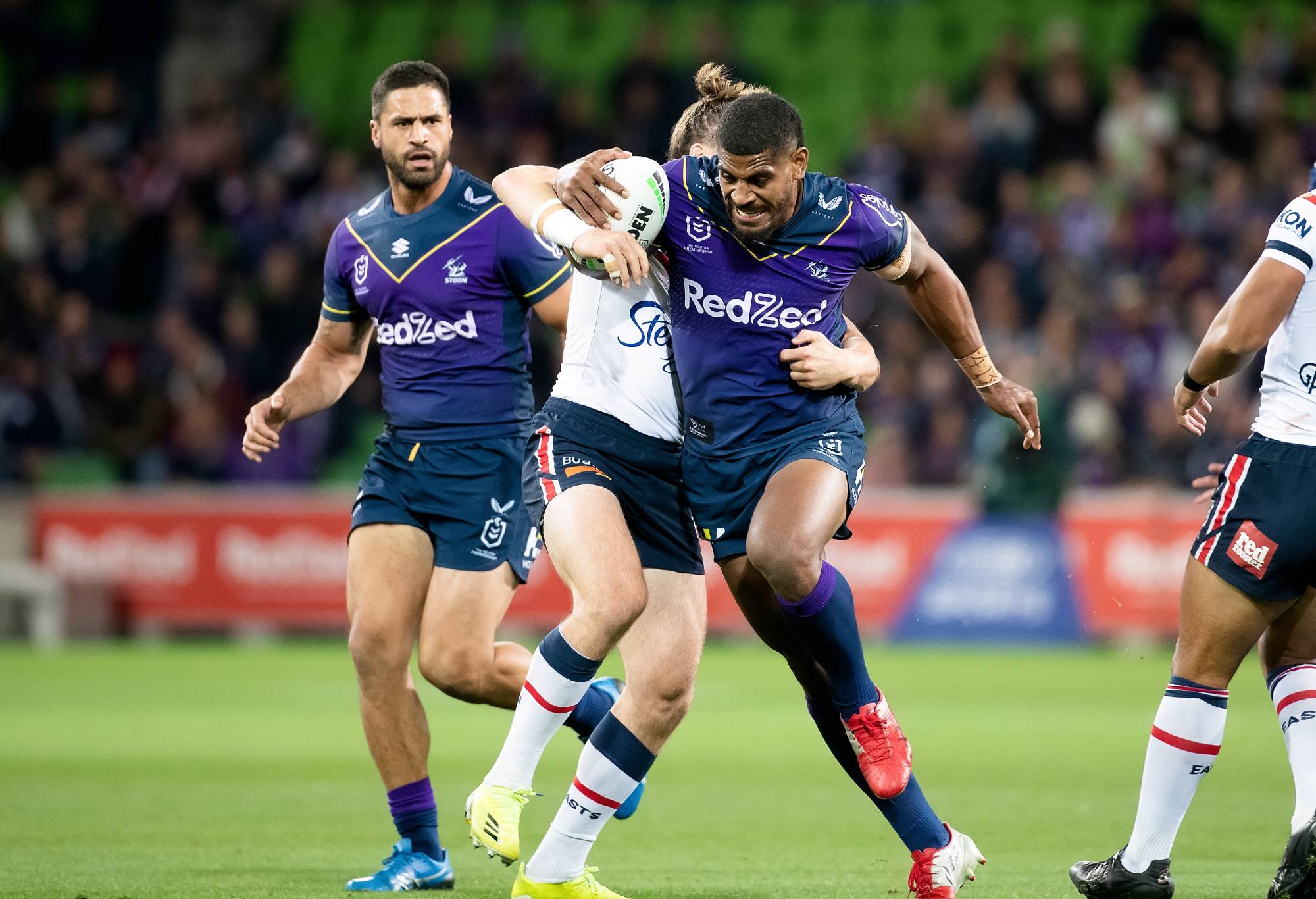
(Photo by Speed Media/Icon Sportswire via Getty Images)
Workhorse
This is almost the opposite of the strike player: the workhorse. The key characteristic is minutes, the ability to consistently depend on them to get on the field, stay on the field, make their tackles and allow someone else to have the x factor.
Melbourne love this player: Felise Kaufusi and Tui Kamikamica (94% tackle efficiency, if you don’t mind) are great examples, as are Tohu Harris and Joe Ofahengaue who can pump out above average numbers of minutes in the middle.
For the king of this position, however, cede the floor to Jake Trbojevic. He’ll give you 80 minutes in the middle, touching the ball a lot, tackling a lot, never making an error and making the most one-man tackles – read, legs tackles – of anyone in the NRL.
Controller
Our first spine position is a pretty obvious one: the controller. The archetypal 7, the controller exists to get the team around the park and kick the ball and let other people flourish.
There’s a lot of obvious high level examples – Chad Townsend and Adam Reynolds the obvious two – but there’s a lot that this position isn’t. They hide in defence, barely run in attack and usually are smaller bodies who can only realistically play one position.
Measure kick metres and pass-to-run ratio, and throw in a LKS – long kicks to space – to see if they’re good at finding the floor, along with traditional halfback metrics like try and lien break assists, plus a whole load of leadership-related intangibles.
When we talk about a ‘pure 7’, this is who we mean.
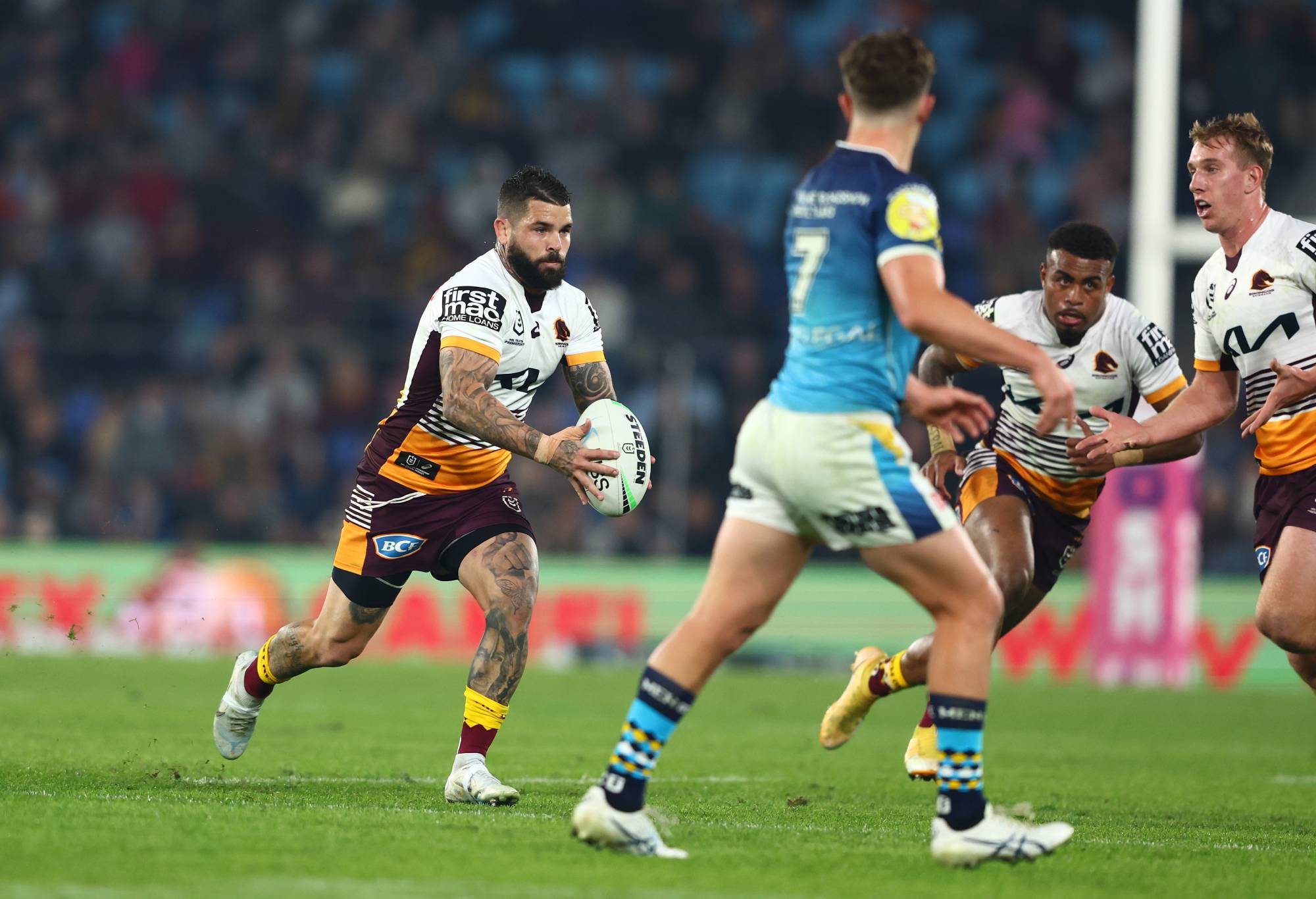
Adam Reynolds. (Photo by Chris Hyde/Getty Images)
Maverick
So what is the opposite of the controller? The maverick. This is also a classic halfback style, rarely suited to any other position, but their specialisation might not be as much focussed on the long kicks and passing, but more on the creativity and spark.
This guy is basically useless in your own half and probably also useless when you don’t have the ball, but their the guy you throw it to three times a set when you need to score. Sam Walker, Nicho Hynes and, king of them all, Ben Hunt are who we are thinking of here.
They have a run, they love a chip and chase, they score tries and assist them. Just don’t ask them to tackle anyone.
Schemer
Halfbacks come in pairs, so if you have a Maverick, then you probably need a schemer in the 6 jumper. The line between the two is quite thin, but you might think of the schemer as the five eighth equivalent of the controller, much more willing to think a few plays ahead, orchestrate a set to hit points of the field and then execute the final pass.
Luke Keary is excellent at this, because he loves to spot up defenders in the line, while Kieran Foran and Luke Brooks are also examples.
You’ll notice them by their above-average possessions for a 6, their greater willingness to take long kicks and their interchangeability with the halfback role – while the Schemer is the cousin of the controller, they do have a run much more frequently.
Runner
When you hear of a run-first mentality for a five eighth – well, here’s your guy. This doesn’t take much explaining, because it is the first principle of some of the best 6s in the game, but this player will have good numbers for tackle breaks, tries, line breaks and probably on the scales, as size matters.
The runner is not in the team only to run, of course, but it’s their first, second and probably third option in good ball. they might have a kick, or a decent pass, but even then: they only get the time to bring it out because the defence is worried about the dart at the line.
Cody Walker would be the obvious choice, but Matt Burton and Dylan Brown are also examples in the five eighth position, but you could add fullbacks like James Tedesco and Kalyn Ponga too, though in their case, it’s a bit reductive.
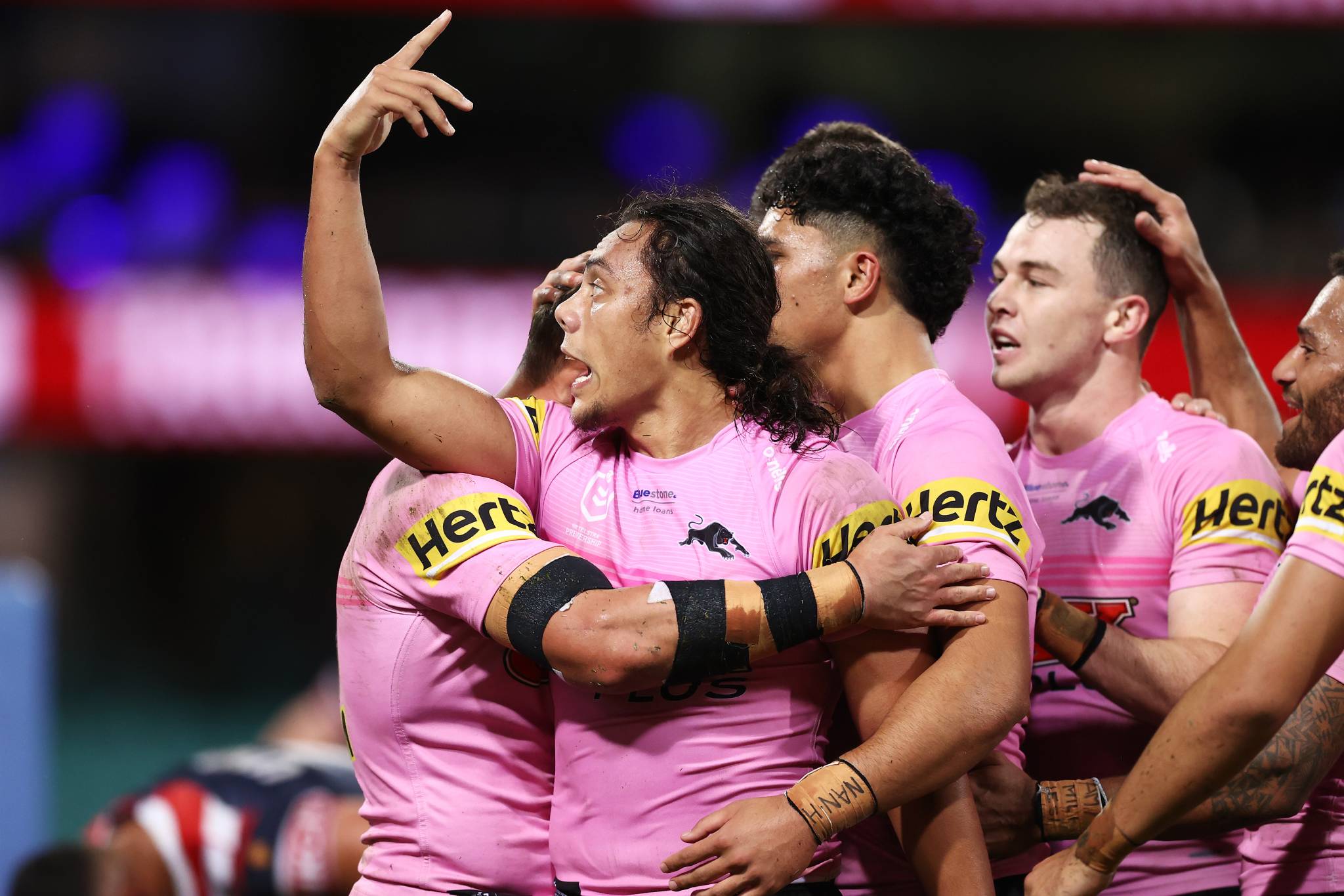
Jarome Luai of the Panthers (Photo by Matt King/Getty Images)
Link man
There’s a lesser spotted spine player out there, someone who isn’t quite a runner, but also isn’t quite a schemer.
They’re your off-the-cuff, smaller-bodied, elusive types who deal in both tries and try assists, but crucially differ from either of the above.
They usually only play one side of the field, unlike a schemer, they beat their man through guile and speed rather than brawn, unlike a runner. They’re also quite useless with the boot for anything other than within the red zone.
Not every team can carry one, because they are certainly a luxury player, but if you can make it work, the link man can bridge middle and edge, single-handedly create broken play and deliver the edge in tight games.
Jarome Luai is probably the best example: he never shifts from the left, he rarely kicks and leaves the organising to someone else, but is top 5 in the comp for all the right metrics for this role: tries, total try involvements, try assists.
There’s not many around, but Ezra Mam and Junior Amone are building nicely into this player.
There are a lot of fullbacks that fulfil this role: Reece Walsh and Scott Drinkwater are basically non-existent defensively, don’t contribute big run metres and don’t have too many touches of the footy, but exist exclusively to polish off attacks.
Disher
There’s two key types of hooker that we need to discuss. The disher is the first, and it’s exactly what it sounds like. Make your tackles in the middle, get behind the ruck and get the ball out of there.
These guys aren’t in the game to run, but instead to manage getting the ball where it needs to go. Their stock in trade, statswise, is tackles, lots of them, plus minutes – usually you want 80 minutes out of this chap – and dummy half runs, or lack thereof.
Reed Mahoney is the ur-example. He plays 80, runs about once per game and has 118 average possessions, the most in the NRL, meaning that he is behind almost every play the ball that Parramatta have, while also posting 40 tackles per game – again the most in the NRL.
Api Koroisau is not as pure an example as Mahoney, but would also be an elite disher.
Dictator
The other is, well, the other type of hooker. The dictator is responsible, above all things, for tempo and direction. They call the shots for the first three tackles of the set, using the position at dummy half to manipulate field position, get the ball to set marks on the field and allow the halfbacks to take over.
They also love to change the speed of the game through dummy half runs – one of the key stats to judge them on – because they’re always on the lookout for the moment to go themselves.
Damien Cook is the obvious standout, with Harry Grant right up there too. They also make a lot of tackles, but it isn’t their calling card in the same way because there’s a lot more that they offer.
Beware, though: the ceding control of your attack to the dictator often leaves you in what I think of as ‘The Cook Paradox’: sure, you’ll get a lot of runs, but also a fair few step out, look to run, then pass anyway incidents that smother your attack. It’s not without reason that some teams prefer the simple disher.

(Photo by Brett Hemmings/Getty Images)
Finisher
Ok, let’s talk backs. The most obvious here is the finisher, the guy who puts the ball over the line most frequently.
Alex Johnston has a lot of try-scoring records because he is good at this. He’s the classic example of the finisher, because he scores a lot but doesn’t do as well in the metrics by which you might measure other wingers: his run metres, for example, barely crack the top 50 in the NRL.
Maika Sivo, who despite his size has relatively poor set starts, is also in this boat, as are Xavier Coates and Jason Saab.
Some teams want different things from their wingers, of course. Everyone would like a winger who scored a million tries and also gave them great set starts, but not everything is possible.
Sometimes things like speed and putdowns are all you can offer, and that’s fine.
Yardage player
The modern winger, as we all know, has to do far more than simply put the ball down. They have to start sets, take hit ups and, if they get the chance, score.
Brian To’o, we all know, is the best at this. Daniel Tupou is not far behind. Though by dint of a) being wingers and b) being good they will also score a lot of tries, that isn’t their principal role in the team.
If you’d like examples of this where they don’t actually score the requisite number of points, then Greg Marzhew and Dom Young also endeavour to be large bodies that take hard carries but in bad teams.
It’s worth adding this role can also be taken by players that aren’t wingers. Dylan Edwards is a superb fullback, but if you asked me his best quality, I’d say his set starts. Reuben Garrick has made a great fist of fullback at Manly without really doing any of the other major fullback creative parts that well, essentially playing as a centrally-based winger.
Siosifa Talakai and Moses Suli do this from the centres, too: they’re not really ever going to pass much and they’re not hugely elusive, but you can measure them in how hard they are to put down in a straight line, and how quick they are to get up afterwards.
Breaker
This is undoubtedly one of the most important roles in the team, but is basically independent of any position.
This is a big, strong, fast ball-player that you want to get into the game at the vital moment. They might have subtlety, but the strength is going to come first. The name comes from tackle breaks, a key metric, but could also be a metaphorical game breaker.
It’s Joey Manu or Kotoni Staggs in the centres, but also Latrell Mitchell and Tom Trbojevic from fullback and Cameron Munster and Jack Wighton from five-eighth. Viliame Kikau and (theoretically at least) David Fifita can do it from the forwards.
The breaker can be listed as a lot of numbers, but it’s usually about how often they get the ball and what their other skillsets are: the role itself is about injecting yourself into the game and making things happen.
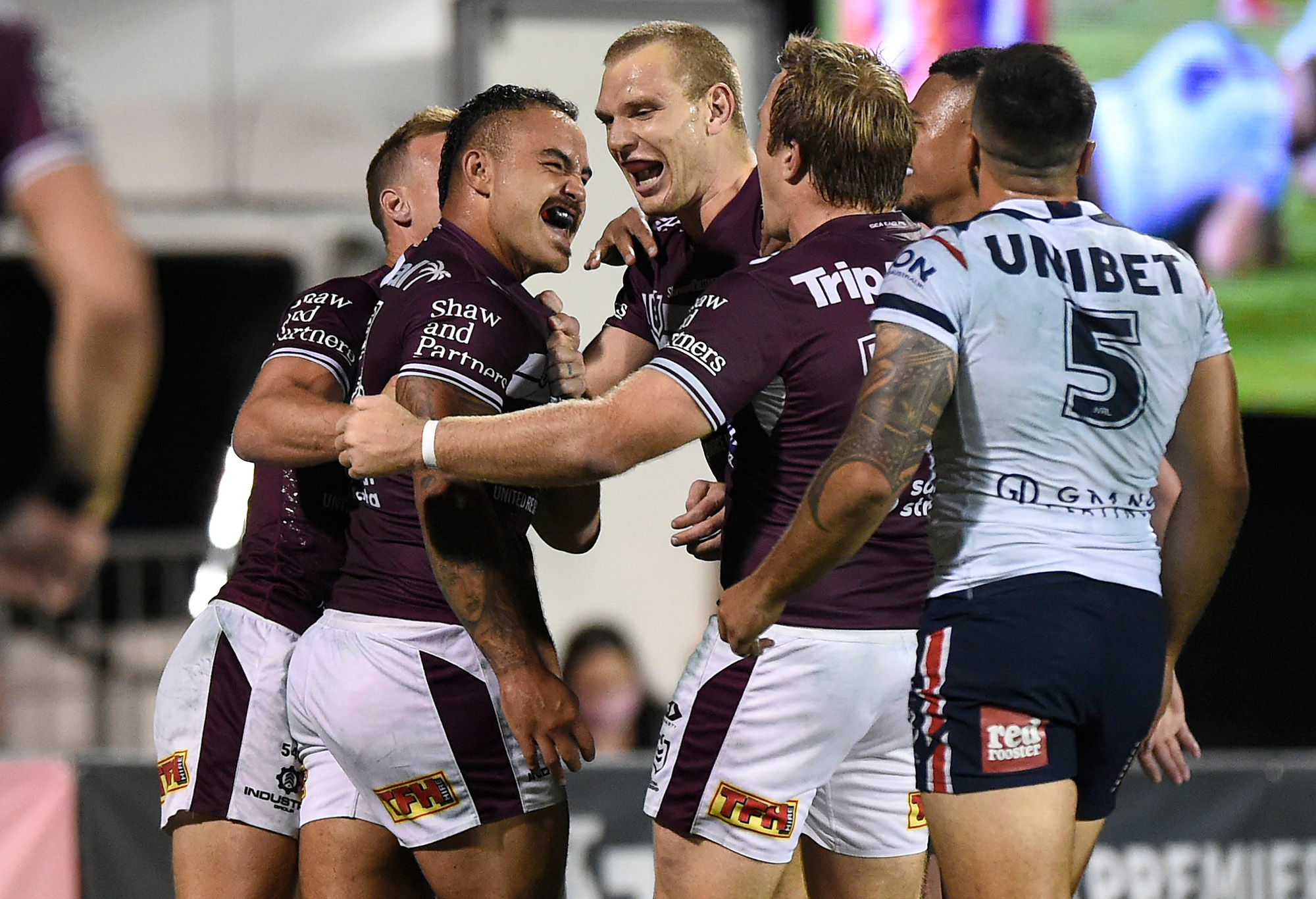
Dylan Walker and the Sea Eagles celebrate a try. (Photo by Matt Roberts/Getty Images)
Spark plug
The spark plug is generally released from the bench and is often a dummy half – Tom Starling, for example – but not necessarily.
Some teams like a spine player to do it, like Drew Hutchison or Phoenix Crossland, whereas other use a bigger body to the same ends, like Dylan Walker or Brandon Smith, who can play in a variety of positions while delivering the same impact.
Speed is the main concern, with the player asked to change the tempo and directly impact the game immediately, but that can also be done via high levels of aggression, taking a lot of carries or making a lot of tackles.
Whatever stat you want to use, you want to use it on a per-minute basis: the spark plug is here for a good time, not for a long time.
Blocker
The blocker might be the vaguest of our roles, because they exist to fill a gap rather than do anything specific. You need one, probably two of these.
In a salary-capped sport, it’s unlikely that you’re going to have superstars in every position, so you need a few dependable guys who can take up the slack while the headline acts take a breather and cover a few roles too.
Like their cousins, the grunts, the blockers are there to generate metres, make tackles and little else, but crucially, to maintain intensity as well. It’s a thankless task in a lot of ways: nobody but your teammates will know what you do.
You probably don’t notice that they’re even on the field, they can be a middle or an edge, probably something else too if needed and really, they’re just punching bags until the big names get their breath back.
Think Karl Lawton, Marata Niukore, Jaeman Salmon or Ray Stone.
Big bopper
The opposite of the blocker – or the fatter cousin of the spark plug – is the big bopper. This is the bloke you bring on to up the tempo, rather than to maintain it. As my father used to say of former Hull FC big bopper Jamie Thackray: they brought him on to start fights.
You might not get many minutes out of a big bopper, so you have to make them count: lots of hard carries, noising up opponents, putting the shots on.
If you have a good combination of blockers and grunts in your team, you can carry a grade a bopper, like Spencer Leniu, Hame Sele or Andrew Fifita to change the pace for 25 minutes either side of half-time – until they run out of breath at least.





































































































